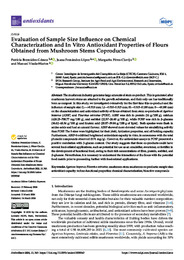Title:
Evaluation of Sample Size Influence on Chemical Characterization and In Vitro Antioxidant Properties of Flours Obtained from Mushroom Stems Coproducts |
Authors:
Bermúdez Gómez, Patricia 
Fernandez-Lopez, Juana 
PÉREZ CLAVIJO, MARGARITA 
Viuda-Martos, Manuel  |
Editor:
MDPI |
Department:
Departamentos de la UMH::Tecnología Agroalimentaria |
Issue Date:
2024-03-14 |
URI:
https://hdl.handle.net/11000/35006 |
Abstract:
The mushroom industry generates large amounts of stem co-product. This is generated after mushroom harvest; stems are attached to the growth substratum, and their only use has traditionally been as compost. In this study, we investigated extensively for the first time this co-product and the influence of sample size (L—>0.510 mm; LI—0.510–0.315 mm; SI—0.315–0.180 mm; S—<0.180 mm) on the characterization and antioxidant activity of flours obtained from stem co-products of Agaricus bisporus (ABSF) and Pleurotus ostreatus (POSF). ABSF was rich in protein (14 g/100 g), calcium (428.23–700.77 mg/100 g), and sorbitol (22.57–26.60 g/100 g), while POSF was rich in β-glucans (36.62–40.34 g/100 g) and linoleic acid (20.57–39.86 g/100 g of lipid). Both species were flush in amino acids and had an umami flavour. ABSF showed more elevated values for emulsifying activity than POSF. The S sizes were highlighted for their yield, hydration properties, and oil holding capacity. Furthermore, ABSF-S exhibited heightened antioxidant capacity in vitro, in consonance with the total phenolic compounds observed (0.91 mg/g). However, the antioxidant assays in POSF presented a positive correlation with β-glucan content. Our study suggests that these co-products could have several food-related applications, such as potential for use as an emulsifier, sweetener, or fortifier in the development of functional food, owing to their rich concentrations of fibre, protein, sorbitol, and β-glucans. Nevertheless, it is necessary to understand the interactions of the flours with the potential food matrix prior to proceeding further with food-related applications
|
Keywords/Subjects:
Agaricus bisporus
Pleurotus ostreatus
Mushroom stem
Mushroom co-products
Sample size
Antioxidant capacity
Techno-functional properties
Chemical characterization
Bioactive compounds |
Type of document:
info:eu-repo/semantics/article |
Access rights:
info:eu-repo/semantics/openAccess
Attribution-NonCommercial-NoDerivatives 4.0 Internacional |
DOI:
https://doi.org/10.3390/antiox13030349 |
Published in:
Antioxidants 2024, 13, 349 |
Appears in Collections:
Artículos Tecnología Agroalimentaria
|

.png)
